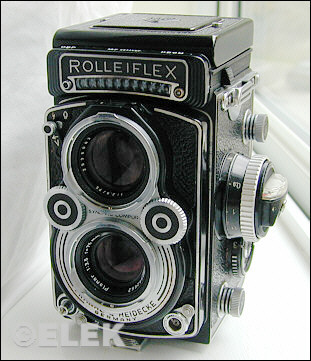Rolleiflex 3.5F

|
|
|
| Style, film format | Twin-lens reflex, 120 roll film with coupled selenium meter |
|
|
|
| Lens, shutter | 75mm f/3.5 Carl Zeiss Planar, Compur-Synchro |
|
|
|
| Photo quality | Excellent |
|
|
|
| Ergonomics | Like all TLRs, not a speed camera |
|
|
|
This is one of my favorite cameras. Sure, it doesn't have the speed of the f/2.8 Planar, but let me tell you that the 3.5F Planar is a great camera to shoot wide open or stopped down. And we're only talking about a single stop, so that's not much of a difference in the long run.
One thing you'll notice is the weight. The final cameras in the series tipped the scales at close to four pounds. But the weight is in a fairly compact package that sits comfortably from your neck (strong shoulders help here) and sits squarely in your hands.
The controls are positive and well-finished, like all Rolleiflexes. The leaf shutter is quiet and inaudible out on the street, if you use it for that. Indoors, it's fine for candids, although fast film would be a great idea.
The 3.5F models arrived on the scene just as Japan's SLRs began to take over the professional market for news photographers and Hasselblad in the studio. Try as it might, a 12-shot Rolleiflex with a fixed lens (no matter how great) couldn't compete with the new kids on the block. The heyday of the twin-lens reflex had come to an end.
Happily, these are in plentiful supply today, although collectors have driven up the prices to unreasonable levels, especially on the "F" models. But if you can find one, you'll love it.
Any twin-lens Rolleiflex is a camera for life.
